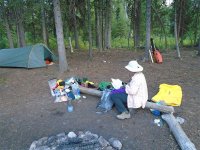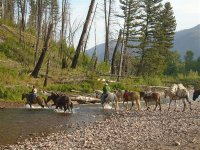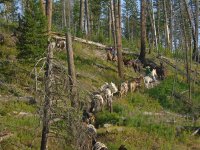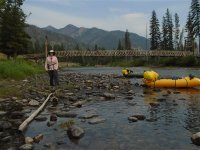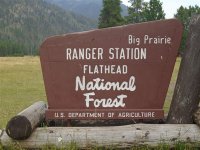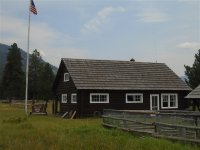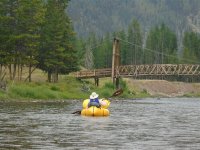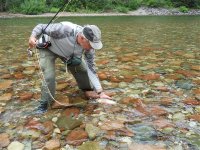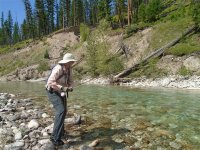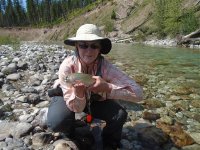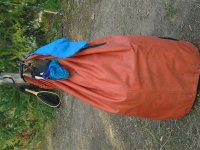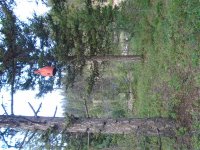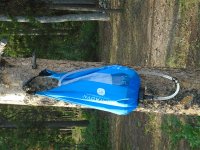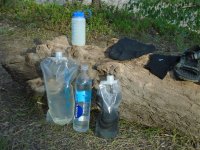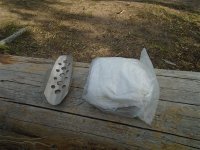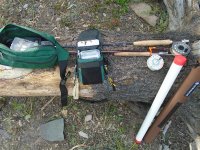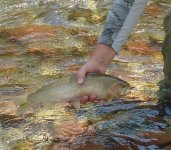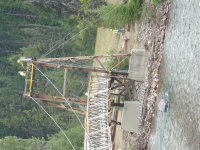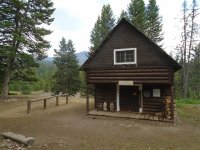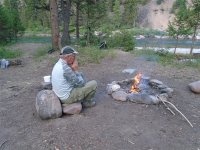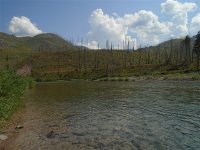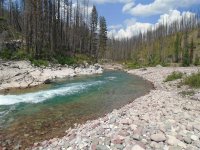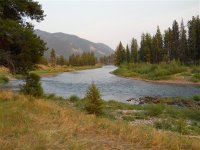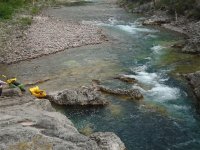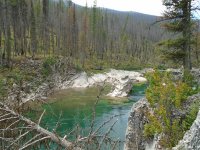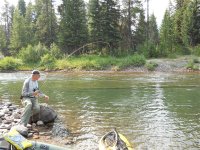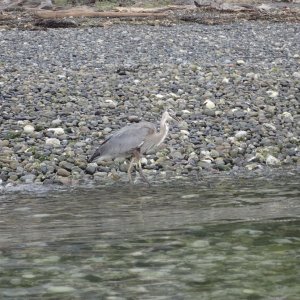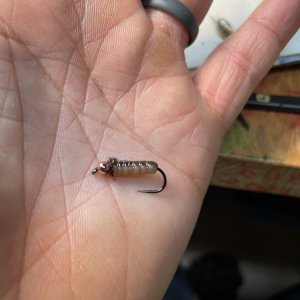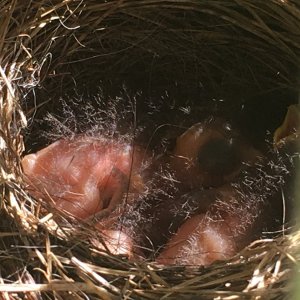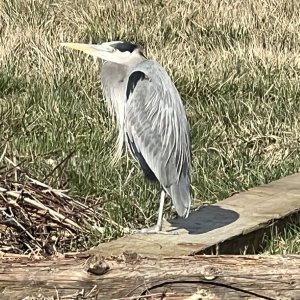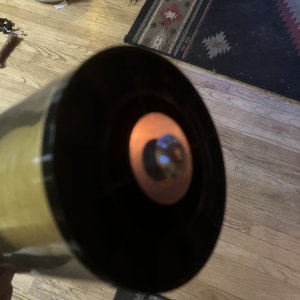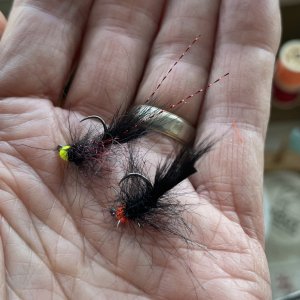July - August 2018
The South Fork Flathead River heads in the Bob Marshall Wilderness and flows from south to north, eventually ending up in Hungry Horse Reservoir before joining the Middle Fork near Columbia Falls, Montana. I’d long heard about “the Bob” and one day making a wilderness trek there. Then I learned about “packrafting” and the feasibility it lends to a trip of this sort. My usual fishing friends and victims either couldn’t or wouldn’t make the trip, but my wife, Mrs. Salmo, good sport that she is and always ready to try an adventure, said sure, she’d like to do this trip with me.
The trip involves either backpacking into the wilderness or riding a horse into it. There is no route to the upper South Forth that is less than 20 miles. Given that the trip would be 7 or 8 days, and with food at about 2#/person/day I figured out that our backpacks wouldn’t hold all the food and gear we’d need for the trip. Through a blind luck contact here on the forum I reached an outfitter who packs into the area I wanted to reach, so we could ride horses in with our packs and gear, then float, fish, and camp our way downriver to the designated take out upstream of Meadow Creek Gorge and hike out with our then emptier backpacks after having eaten almost all of the food we carried in. At least that was how the plan was evolving. And the outfitter provided a shuttle service, taking our car from the trailhead on the SW side of the wilderness area to the Meadow Creek trailhead on the north end.
If you’re just looking for the thumbnail sketch trip report, it goes like this: it was harder than I expected, and we expected to spend more time fishing.
We dropped off our gear at the outfitter corral at Owl Creek trailhead Sunday afternoon July 29, stayed that night at a nearby B&B, and returned to the trailhead Monday morning to head into “the Bob.” Being the tallest person in our group (we were paired up with another party of four) I was assigned to ride the mule named Belle. If mules are measured in “hands” like horses, then Belle was a couple dozen of them. Those long legs positioned the saddle stirrup nearly shoulder high on me, or so it seemed. It was a minor struggle to saddle up and climb aboard my mule named Belle. Mrs. Salmo was assigned to a smallish horse named Lady, and it happens that Belle just follows Lady wherever she goes. Since Belle gets a new rider every trip, she has no need nor use for instruction or input of any sort from the likes of me. It was pointless for me to tell her “giddyup” or anything else. Belle walks forward, turns left or right, and stops wherever and whenever Lady does. That’s how that relationship works, and it would have been absolutely pointless for me to try in any way to alter it.
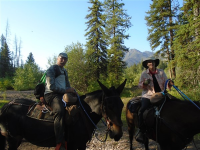
Mounted on Belle and Lady.
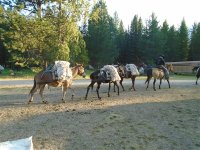
The pack string took off a little ahead of us.
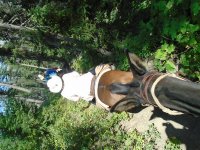
Belle follows Lady; that's just how it is with them.
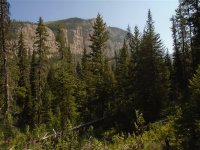
Much of the forested area in the Bob has burned, but not all of it.
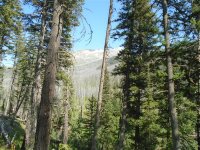
But lots of it has burned.
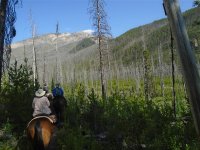
A whole lot of it has burned. We saw sights like this most of the week along the river.
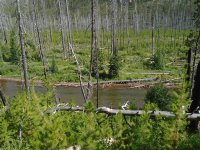
Here's a section along Gordon Creek, also burned.

Think of it as the rebirth of a new forest and it doesn't seem quite so bad. Never saw so much fireweed sprouting up in my life.
About riding horses, I rode horses when I was a kid. Even rode bareback a lot, saddles being expensive and me being poor and all that. However, I can’t remember riding a horse in the last 50 years. Fortunately it’s a lot like riding a bicycle, you never really forget. Mrs. Salmo probably hasn’t ridden a horse for 20 years. Just for reference, we have experience, just not current.
Another thing about riding horses, most people ride for an hour or two at a time, not all day. I don’t think I ever rode for more than 2 ½ hours in any one day when I was a youngster. The route we took into the Bob was 26 miles and a 9 ½ hour ride. Even the outfitter and wranglers who do this regularly say it’s brutal. But it gets us where we are going, and in one day instead of two. Another thing they say about riding saddle stock, if your legs hurt, the stirrups are too short. If your butt hurts, the stirrups are too long. If both your legs and butt hurt, then the stirrups are adjusted just right. And Salmo says, if you don’t go on long horseback rides regularly, wear cycling shorts with a good gel chamois under your pants. It helps. A lot, I’d say. At five hours in, Mrs. Salmo and I were feeling fine, and I thought if it gets no worse than that, then we’ve got it made. Well guess what? Yep, it can only get worse, and worse it did get. My butt ached so back when we finally reached the South Fork, it was all I could do to dismount. We said goodbye to our trusty saddle steeds and retrieved our packed gear from one of the mules and went about making our first night’s camp.
Guess I should do this in segments.
The South Fork Flathead River heads in the Bob Marshall Wilderness and flows from south to north, eventually ending up in Hungry Horse Reservoir before joining the Middle Fork near Columbia Falls, Montana. I’d long heard about “the Bob” and one day making a wilderness trek there. Then I learned about “packrafting” and the feasibility it lends to a trip of this sort. My usual fishing friends and victims either couldn’t or wouldn’t make the trip, but my wife, Mrs. Salmo, good sport that she is and always ready to try an adventure, said sure, she’d like to do this trip with me.
The trip involves either backpacking into the wilderness or riding a horse into it. There is no route to the upper South Forth that is less than 20 miles. Given that the trip would be 7 or 8 days, and with food at about 2#/person/day I figured out that our backpacks wouldn’t hold all the food and gear we’d need for the trip. Through a blind luck contact here on the forum I reached an outfitter who packs into the area I wanted to reach, so we could ride horses in with our packs and gear, then float, fish, and camp our way downriver to the designated take out upstream of Meadow Creek Gorge and hike out with our then emptier backpacks after having eaten almost all of the food we carried in. At least that was how the plan was evolving. And the outfitter provided a shuttle service, taking our car from the trailhead on the SW side of the wilderness area to the Meadow Creek trailhead on the north end.
If you’re just looking for the thumbnail sketch trip report, it goes like this: it was harder than I expected, and we expected to spend more time fishing.
We dropped off our gear at the outfitter corral at Owl Creek trailhead Sunday afternoon July 29, stayed that night at a nearby B&B, and returned to the trailhead Monday morning to head into “the Bob.” Being the tallest person in our group (we were paired up with another party of four) I was assigned to ride the mule named Belle. If mules are measured in “hands” like horses, then Belle was a couple dozen of them. Those long legs positioned the saddle stirrup nearly shoulder high on me, or so it seemed. It was a minor struggle to saddle up and climb aboard my mule named Belle. Mrs. Salmo was assigned to a smallish horse named Lady, and it happens that Belle just follows Lady wherever she goes. Since Belle gets a new rider every trip, she has no need nor use for instruction or input of any sort from the likes of me. It was pointless for me to tell her “giddyup” or anything else. Belle walks forward, turns left or right, and stops wherever and whenever Lady does. That’s how that relationship works, and it would have been absolutely pointless for me to try in any way to alter it.

Mounted on Belle and Lady.

The pack string took off a little ahead of us.

Belle follows Lady; that's just how it is with them.

Much of the forested area in the Bob has burned, but not all of it.

But lots of it has burned.

A whole lot of it has burned. We saw sights like this most of the week along the river.

Here's a section along Gordon Creek, also burned.

Think of it as the rebirth of a new forest and it doesn't seem quite so bad. Never saw so much fireweed sprouting up in my life.
About riding horses, I rode horses when I was a kid. Even rode bareback a lot, saddles being expensive and me being poor and all that. However, I can’t remember riding a horse in the last 50 years. Fortunately it’s a lot like riding a bicycle, you never really forget. Mrs. Salmo probably hasn’t ridden a horse for 20 years. Just for reference, we have experience, just not current.
Another thing about riding horses, most people ride for an hour or two at a time, not all day. I don’t think I ever rode for more than 2 ½ hours in any one day when I was a youngster. The route we took into the Bob was 26 miles and a 9 ½ hour ride. Even the outfitter and wranglers who do this regularly say it’s brutal. But it gets us where we are going, and in one day instead of two. Another thing they say about riding saddle stock, if your legs hurt, the stirrups are too short. If your butt hurts, the stirrups are too long. If both your legs and butt hurt, then the stirrups are adjusted just right. And Salmo says, if you don’t go on long horseback rides regularly, wear cycling shorts with a good gel chamois under your pants. It helps. A lot, I’d say. At five hours in, Mrs. Salmo and I were feeling fine, and I thought if it gets no worse than that, then we’ve got it made. Well guess what? Yep, it can only get worse, and worse it did get. My butt ached so back when we finally reached the South Fork, it was all I could do to dismount. We said goodbye to our trusty saddle steeds and retrieved our packed gear from one of the mules and went about making our first night’s camp.
Guess I should do this in segments.
Last edited by a moderator:

